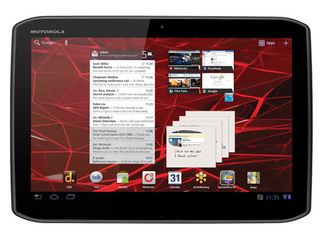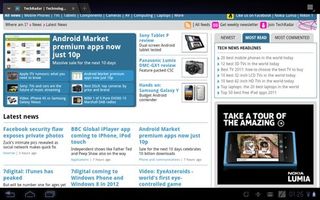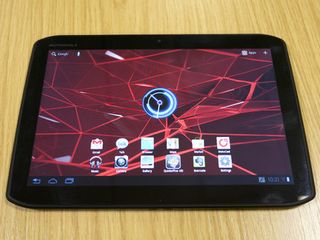Why you can trust TechRadar

Performance
The Motorola Xoom 2's most noticeable upgrade might be in the chassis, but it's also had an upgrade to a 1.2GHz CPU, along with Android 3.2.
This has produced a tablet that's quite snappy overall, though it does still suffer from the odd moment where swipes take a moment to register. The only real disappointment when it comes to performance in the operating system is switching orientation.
It almost always takes a couple of seconds to switch, no matter if you're just on the Home screen or if you're in a resource-intensive app. It doesn't spoil the tablet or anything, but it's an annoyance that most its competitors don't have (save for the HP TouchPad, which was much, much worse).
But, overall, the Xoom 2 is as smooth to use as the likes of the Samsung Galaxy Tab 10.1, and isn't far off the Asus Eee Pad Slider's slick operation at all.
We found the keyboard on the Xoom 2 to be one of its weaker points, with lots of taps going astray. It just doesn't sit as comfortably under the fingers as the iPad 2's or the HP TouchPad's (and obviously the physical keyboard option for the Asus Eee Pad Slider and Transformer are better), possibly due to the difference in screen shape.

The screen itself is nice and clear, with natural colours that look great for video. The 1280 x 800 resolution means that text is nice and clear, too. The brightness is our only small concern – it just isn't that bright, and the auto-brightness doesn't help by being really quite aggressive.
We had to keep the brightness up at maximum pretty much always, even just in regular household lighting (as opposed to harsh tungsten office lights, for example). Certainly, the screen is bright enough for almost any use, but there's really no margin for boosting it further in really bright artificial light, or sunlight.
Alas, there's another small problem with the screen: the backlight. There are a few spots where it bleeds through quite noticeably, particularly when on a screen with a dark background, including the Settings screen. You won't notice it all the time, but it's disappointing.
Despite that, we do think the screen on the Xoom 2 is pretty good overall, and it needs to be, because there's no doubt this is a media-focussed tablet. Instead of dragging and dropping media to it when plugged in over USB, you use MotoCast USB to bring over things like iTunes playlists, or select media from folders.
Like Windows Phone Connector, it'll automatically convert videos if they're in a format the Xoom 2 can't play natively (though Motorola's software is better than Microsoft's, because it doesn't insist on also converting the stuff that was fine to begin with).

The MotoCast USB software was a bit hit-and-miss, though; it crashed on us a lot, making it impossible to get anything on the device. But when it worked, it worked fine.
Everything's easy to access on the device, with music in the Music app and photos and videos in the Gallery app. The Music is a bit slow in landscape when you've got a decent collection, but is faster to flick through in portrait.
1080p video plays back smoothly, except not over the HDMI port – everything mirrors smoothly when you connect to an HDTV, except for all video that plays back in the main Android player. You just get the controls with a black screen behind them. Not ideal.
The wireless MotoCast app works quite well on a local network, except for one significant flaw. Though it connects seamlessly to the folders you set it up with, it often misreported the contents of video folders for us. It listed everything fine, but when we tapped on what we wanted, it sometimes opened something else. It was like a shuffle function for our videos that we couldn't turn off. Superb.
Actually streaming something is the part that works. We had occasional stutters, but it was mostly fine. Go outside your local network and you'll encounter more struggles, though.
Because it's not actually coming from the cloud, but from your PC, you'll need a really good upload speed to get anything out of it. More than that, though, your computer must be up and running for it to work. If it goes on standby, you'll find that you'll get an 'offline' message when you try to access it.
MotoCast is a nice idea, and could be a great addition to make Motorola's tablet stand out, but it needs more work.
The loudspeakers on the Xoom 2 can go loud enough for most situations, but they make the whole back of the tablet vibrate when they're loud, and the sound gets much more distorted at high volumes than it does on, say, the iPad.
The browser on the Xoom 2 proved to be fairly snappy, though Opera Mobile is also included, should you want to go that route. Adobe Flash is preinstalled, so consider that box ticked.
As we said, the browser is fairly fast, with pages loading quickly for the most part, but loading Flash content does hold many pages back compared those without Flash.
And the old spectre of Flash causing the responsiveness of the browser to slow is also present, but even with a video on the page, zooming and panning is pretty good. And you can pinch to zoom and pan around the page at the same time! (It's something a surprising number of Android devices lack the ability to do.)
In real life, we're not looking at the fastest tablet browser around in the Xoom 2, but it's fast enough that it won't make much difference day to day.
Battery life
For battery life, the Xoom 2 made a good account of itself, though it was slightly up and down. Whereas some Android tablets have problems keeping power use to a minimum on standby, the Xoom 2 was very good, and we're sure it'd be able to last you for days on end (rather than misplacing a fifth of its battery overnight, as some do).
That said, it's surprising just how much power certain aspects of the Xoom 2 use. At one point, we managed to use 20% of the battery during about an hour of internet testing.
Granted, we were loading sites over and over, and testing Flash performance a lot, but it seemed a little much. We did have the screen's brightness turned all the way up, but it has to be in a well-lit room, or it's a little hard to see what you're doing.
But, there have been plenty of other times we've been using the Xoom 2 more sporadically, and the battery use hasn't gone down far at all.
Ultimately, the iPad 2 is still the tablet battery life king, but the Xoom 2 does quite well for itself. Just mind the Flash content.
The built-in GPS chip worked quite well for us, narrowing us down quickly. With no 3G to stream maps, it's a slightly odd addition, but we can't knock it for functionality.
The camera on the Xoom 2 is decent enough, capturing accurate colours and crisp lines, and letting in a good amount of light even in low light. The detail can be a little soft, but overall they're good snaps.
Similarly, the 720p HD video is passable, if not spectacular. It's not up to par with better dedicated cameras, or the best phones, but you can make out what's happening easily, though fast motion can become quite blurred.

This has to be the most absurd portable power station ever launched — Asus's Mjolnir throws the hammer at rivals with innovative design that's likely to divide opinions

Pixel's new satellite feature could show people where you are on Google Maps

I really hope Google doesn't promise 7 years of Android for the Pixel 8a
